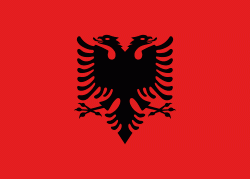Korçë (Bashkia Korçë)
Korçë (Korça) is the eighth most populous city of the Republic of Albania and the seat of Korçë County and Korçë Municipality. The total population is 75,994 (2011 census), in a total area of 806 km2. It stands on a plateau some 850 m above sea level, surrounded by the Morava Mountains.
The area of the Old Bazaar, including Mirahori Mosque, is considered as the urban core of the city. Founded by a local Ottoman Albanian lord, Ilias Bey Mirahori, the urban area of Korçë dates back to the late 15th century and the beginning of the 16th century, however its actual physiognomy was realized in the 19th century, during a period that corresponds with the rapid growth and development of the city. The Old Bazaar has played a dominant role in Albania's market history. Korçë is the largest city of eastern Albania and an important cultural and industrial centre.
Korçë is named differently in other languages: Curceaua, Curceao or Curciau; Serbian, Bulgarian and Macedonian: Горица, Goritsa; Κορυτσά, Korytsa; Coriza; Görice. The current name is of Slavic origin. The word "gorica" means "hill" in South Slavic languages, and is a very common toponym in Albania and Slavic countries (e.g. Podgorica in Montenegro, Gorizia, Dolna Gorica in the Pustec municipality, and so on). It is diminutive of the Slavic toponym "gora", meaning mountain, which is also found in placenames throughout Slavic countries as well as non-Slavic countries like Albania, Greece and Italy.
The area of the Old Bazaar, including Mirahori Mosque, is considered as the urban core of the city. Founded by a local Ottoman Albanian lord, Ilias Bey Mirahori, the urban area of Korçë dates back to the late 15th century and the beginning of the 16th century, however its actual physiognomy was realized in the 19th century, during a period that corresponds with the rapid growth and development of the city. The Old Bazaar has played a dominant role in Albania's market history. Korçë is the largest city of eastern Albania and an important cultural and industrial centre.
Korçë is named differently in other languages: Curceaua, Curceao or Curciau; Serbian, Bulgarian and Macedonian: Горица, Goritsa; Κορυτσά, Korytsa; Coriza; Görice. The current name is of Slavic origin. The word "gorica" means "hill" in South Slavic languages, and is a very common toponym in Albania and Slavic countries (e.g. Podgorica in Montenegro, Gorizia, Dolna Gorica in the Pustec municipality, and so on). It is diminutive of the Slavic toponym "gora", meaning mountain, which is also found in placenames throughout Slavic countries as well as non-Slavic countries like Albania, Greece and Italy.
Map - Korçë (Bashkia Korçë)
Map
Country - Albania
 |
 |
| Flag of Albania | |
Albania has been inhabited by different civilisations over time, such as the Illyrians, Thracians, Ancient Greeks, Romans, Byzantines, Venetians, and Ottomans. The Albanians established the autonomous Principality of Arbër in the 12th century. The Kingdom of Albania and Principality of Albania formed between the 13th and 14th centuries. Prior to the Ottoman conquest of Albania in the 15th century, the Albanian resistance to Ottoman expansion into Europe led by Skanderbeg won them acclaim over most of Europe. Albania remained under Ottoman rule for nearly five centuries, during which many Albanians (known as Arnauts) attained high-ranking offices in the empire, especially in the Southern Balkans and Egypt. Between the 18th and 19th centuries, cultural developments, widely attributed to Albanians having gathered both spiritual and intellectual strength, conclusively led to the Albanian Renaissance. After the defeat of the Ottomans in the Balkan Wars, the modern nation state of Albania declared independence in 1912. In the 20th century, the Kingdom of Albania was invaded by Italy, which formed Greater Albania before becoming a protectorate of Nazi Germany. Enver Hoxha formed the People's Socialist Republic of Albania after World War II, modeled under the terms of Hoxhaism. The Revolutions of 1991 concluded the fall of communism in Albania and eventually the establishment of the current Republic of Albania.
Currency / Language
| ISO | Currency | Symbol | Significant figures |
|---|---|---|---|
| ALL | Albanian lek | L | 2 |
| ISO | Language |
|---|---|
| SQ | Albanian language |
| EL | Greek language |















